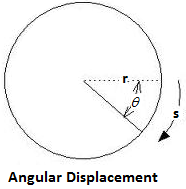Angular Displacement
Angular displacement is the angle in radians through which a point or line has been rotated in a specified sense about a specified axis. It is the angle of the movement of a body in a circular path. It is the difference between the initial and final angular position of a moving body. It has both magnitude and direction.
Conventionally, clockwise movements are described as positive and anticlockwise movements as negative. Also, angular displacement of human body segments usually indicate the type of joint movement.
What is Angular Displacement?
Angular Displacement is the angle made by a body while moving in a circular path. When a rigid body is rotating about its own axis, motion ceases to become a particle. It is so because in a circular path velocity and acceleration can change at any time. The rotation of rigid bodies which will remain constant throughout the duration of rotation, over a fixed axis is called rotational motion.
The angle made by the body from its point of rest at any point in the rotational motion is called as Angular Displacement.
Measurement of Angular Displacement: Angular Displacement is measured in radians rather than degrees, because it provides a relationship between distance travelled around the circle and the distance from the centre.

It can be measured by using formula:
θ = s/ r
Where,
θ = Angular Displacement,
s = Distance travelled by the body,
r = Radius of the circle.
The displacement of object is the distance travelled by it around the circumference of a circle divided by its radius.
